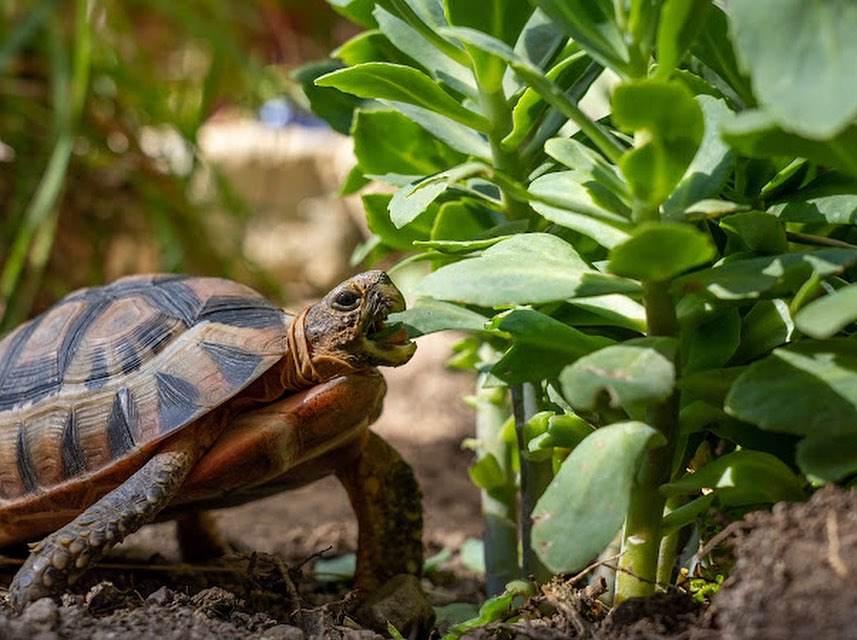– The biological characteristics and natural behaviors of the Bowsprit Tortoise (Chersina angulata)
– The ecological significance of succulents in the diet of the Bowsprit Tortoise
– Conservation efforts and the role of reserves in protecting the Bowsprit Tortoise in South Africa
– The challenges and strategies of zoo management for the Bowsprit Tortoise
– The global importance of wildlife conservation and the impact on species like the Bowsprit Tortoise
With its distinct habits and preferences, the Bowsprit Tortoise (Chersina angulata) occupies a unique niche in the wild. As a species that relishes the crunch of succulent plants, this tortoise provides an interesting case study of reptiles‘ adaptability to arid environments and the delicate balance required to maintain their populations.
Native to the arid regions of South Africa, these tortoises are superbly adapted to their environment. Their domed, osteoderm-embedded shells act as a shield against predators, and their sturdy limbs, equipped with strong claws, are perfect for digging and scraping away tough vegetation. Measuring up to 30 centimeters, the Bowsprit Tortoise exhibits sexual dimorphism, with females tending to be larger than males.
Succulents, a primary food source for the Bowsprit Tortoise in its native habitat, offer nutrition and hydration. These plants have evolved to store water in their leaves, stems, or roots, which tortoises can access during the dry season when water is scarce. The digestion process allows these creatures to extract the maximum amount of moisture from their diet, maintaining hydration even in the most challenging environments.
However, the diet of this species is not limited to these plants alone. They are opportunistic feeders and will consume various foods available in their habitat. The Bowsprit Tortoise has also been observed feeding on small invertebrates, which provide additional protein. Their dietary flexibility is crucial to their survival and highlights the importance of preserving their diverse habitat.
Conservation efforts to protect the Bowsprit Tortoise are ongoing, particularly at the Geometric Tortoise Reserve in South Africa. These protected areas harbor a haven for these tortoises and conserve the rich variety of succulents they depend on. The reserves play a crucial role in research, providing vital information on the tortoise’s behavior, breeding patterns, and health, which is indispensable for their continued conservation.
In zoo management, the effort to replicate the Bowsprit Tortoise’s natural habitat is challenging and vital. Enclosures must provide a gradient of humidity and temperature that mimics their native environment, while diet must be carefully managed to mimic the nutritional value of their natural food sources. It is also important to manage breeding programs effectively to maintain genetic diversity within captive populations, an effort that mirrors the complexity of conservation in the wild.
The broader picture of wildlife conservation is a testament to the interconnectedness of species and ecosystems. Efforts made to preserve the Bowsprit Tortoise also protect many other species that share their habitat. Conservationists work tirelessly to address threats such as habitat destruction, climate change, and illegal wildlife trade, which can devastate local populations and ecosystems.
Furthermore, environmental education, like the Bowsprit Tortoise, is key in increasing public awareness about species’ needs. By promoting a better understanding of the intricate relationships within ecosystems, individuals can be encouraged to support conservation efforts. This support is not only vital for the species’ survival but also preserves the heritage of biodiversity for future generations.
The persistent challenges wildlife conservationists face in protecting species like the Bowsprit Tortoise emphasize the importance of global cooperation. International funding, research collaboration, and policy-making are critical to a successful conservation strategy. Each effort provides a building block toward sustaining and recovering populations of endangered species.
Through the Bowsprit Tortoise’s lens, one can appreciate the complex interplay between species and their environment. It exemplifies how dietary preferences, shaped by millions of years of evolution, can define a species’ ecological roles. As such, it is more than just a reptile enjoying its meal—it is a living piece of a complex ecological puzzle that scientists and conservationists are striving to protect.
By focusing on the well-being of species like the Bowsprit Tortoise, society can continue to forge a path toward a sustainable future where human development proceeds in harmony with the natural world. This pursuit of balance underlies all conservation efforts, ensuring that the *crunch* of a tortoise feeding on its favored succulents remains a sound that signifies both sustenance and the success of environmental stewardship.
*****
Source Description
You just know that crunch is going to be excellent. 🍽️ This Bowsprit Tortoise (Chersina angulata) is doing what they do best: going to town on succulents, a favorite food in their natural habitat! We love this species, and in fact, we even protect a population of them on our Geometric Tortoise Reserve in South Africa, where they have plenty of juicy succulents to devour!


